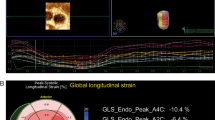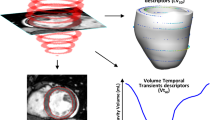Abstract
Cardiac magnetic resonance imaging (Cardiac MRI) has become a gold standard diagnostic technique for the assessment of cardiac mechanics, allowing the non-invasive calculation of left ventricular long axis longitudinal shortening (LVLS) and absolute myocardial torsion (AMT) between basal and apical left ventricular slices, a movement directly related to the helicoidal anatomic disposition of the myocardial fibers. The aim of this study is to determine AMT and LVLS behaviour and normal values from a group of healthy subjects. A group of 21 healthy volunteers (15 males) (age: 23–55 y.o., mean: 30.7 ± 7.5) were prospectively included in an observational study by Cardiac MRI. Left ventricular rotation (degrees) was calculated by custom-made software (Harmonic Phase Flow) in consecutive LV short axis planes tagged cine-MRI sequences. AMT was determined from the difference between basal and apical planes LV rotations. LVLS (%) was determined from the LV longitudinal and horizontal axis cine-MRI images. All the 21 cases studied were interpretable, although in three cases the value of the LV apical rotation could not be determined. The mean rotation of the basal and apical planes at end-systole were −3.71° ± 0.84° and 6.73° ± 1.69° (n:18) respectively, resulting in a LV mean AMT of 10.48° ± 1.63° (n:18). End-systolic mean LVLS was 19.07 ± 2.71%. Cardiac MRI allows for the calculation of AMT and LVLS, fundamental functional components of the ventricular twist mechanics conditioned, in turn, by the anatomical helical layout of the myocardial fibers. These values provide complementary information about systolic ventricular function in relation to the traditional parameters used in daily practice.








Similar content being viewed by others
References
Torrent Guasp F (1966) Sobre morfología y funcionalismo cardiacos (partes I, II y III). Rev Esp Cardiol 19: 48–55, 56–71, 72–82
Torrent Guasp F (1980) La estructuración macroscópica del miocardio ventricular. Rev Esp Cardiol 33:265–287
Internet web page: http://www.torrent-guasp.com/PAGES/Publications.htm
Lorenz C, Pastorek J, Bundy J (2000) Delineation of normal human left ventricular twist troughout systole by tagged cine magnetic resonance imaging. J Cardiovasc Magn Reson 2:97–108
Sengupta PP, Krishnamoorthy VK, Korinek J, Narula J, Vannan MA, Lester SJ et al (2007) Left ventricular form and function revisited: applied translational science to cardiovascular ultrasound imaging. J Am Soc Echocardiogr 20:539–551
Moon MR, Ingels NB Jr, Daughters GT, Stinson EB, Hansen DE, Miller DC (1994) Alterations in left ventricular twist mechanics with inotropic stimulation and volume loading in human subjects. Circulation 89:142–150
Torrent-Guasp F, Ballester M, Buckberg GD, Carreras F, Flotats A, Carrió I et al (2001) Spatial orientation of the ventricular muscle band: physiologic contribution and surgical implications. J Thorac Cardiovasc Surg 122:389–392
Masood S, Yang GZ, Pennell DJ, Firmin DN (2000) Investigating intrinsic myocardial mechanics: the role of MR tagging, velocity phase mapping, and diffusion imaging. J Magn Reson Imaging 12:873–883
Buchalter MB, Weiss JL, Rogers WJ, Zerhouni EA, Weisfeldt ML, Beyar R et al (1990) Noninvasive quantification of left ventricular rotational deformation in normal humans using magnetic resonance imaging myocardial tagging. Circulation 81:1236–1244
Garcia-Barnes J, Gil D, Barajas J, Carreras F, Pujadas S, Radeva P (2006) Characterization of ventricular torsion in healthy subjects using gabor filters and a variational framework. Comput Cardiol 33:887–890
Garcia-Barnes J, Gil D, Pujadas S, Carreras F (2008) A variational framework for assessment of the left ventricle motion. Math Model Nat Phenom 3:76–100
Castillo E, Osman NF, Rosen BD, El-Shehaby I, Pan L, Jerosch-Herold M et al (2005) Quantitative assessment of regional myocardial function with MR-tagging in a multi-center study: interobserver and intraobserver agreement of fast strain analysis with Harmonic Phase (HARP) MRI. J Cardiovasc Magn Reson 7:783–791
Osman NF, McVeigh ER, Prince JL (2000) Imaging heart motion using harmonic phase MRI. IEEE Trans Med Imaging 19:186–202
Montillo A, Metaxas D, Axel L (2004) Extracting tissue deformation using Gabor filter banks. Proc SPIE 5369:1–9
Evans LC (1993) Partial differential equations. Berkeley Math Lect Notes
Duda RO, Hart PE, Stork DG (2001) Pattern classification. Wiley, New York
Sengupta PP, Tajik JA, Chandrasekaran K, Khanderia BK (2008) Twist mechanics of the left ventricle: principles and application. J Am Coll Cardiol Img 1:366–376
Vannan MA, Pedrizzetti G, Li P, Gurudevan S, Houle H, Main J et al (2005) Effect of cardiac resinchronization thereapy on longitudinal and circumferential left ventricular mechanics by velocity vector imaging: description and initial clinical application of a novel method using high-frame rate B-mode echocardiographic images. Echocardiography 22:826–830
Jones CJ, Raposo L, Gibson DG (1990) Functional importance of the long axis dynamics of the human left ventricle. Br Heart J 63:215–220
Ha JW, Lee HC, Kang ES, Ahn CM, Kim JM, Ahn JA et al (2007) Abnormal left ventricular longitudinal functional reserve in patients with diabetes mellitus: implication for detecting subclinical myocardial dysfunction using exercise tissue Doppler echocardiography. Heart 93:1571–1576
Wang J, Khouri DS, Yue Y, Torre-Amione G, Nagueh SF (2008) Preserved left ventricular twist and circumferential deformation, but depressed longitudinal and radial deformation in patients with diastolic heart failure. Eur Heart J 29:1283–1289
Waks E, Prince J, Andrew S (1996) Cardiac motion simulator for tagged MRI. In Proceedings of mathematical methods in biomedical image analysis IEEE, pp 182–191
Liu Y et al (2009) Reconstruction of myocardial tissue motion and strain fields from displacement encoded MR imaging. Am J Physiol Heart Circ Physiol 297(3):H1151–H1162
Buckberg G, Hoffman JIE, Mahajan A, Saleh S, Coghlan C (2008) Cardiac mechanics revisited. Circulation 118:2571–2587
Wang J, Khoury DS, Yue Y, Torre-Amione G, Nagueh SF (2008) Preserved left ventricular twist and circumferential deformation, but depressed longitudinal and radial deformation in patients with diastolic heart failure. Eur Heart J 29:1283–1289
Torrent-Guasp F (1998) Estructura y función del corazón. Rev Esp Cardiol 51:91–102
Ballester M, Ferreira A, Carreras F (2008) The myocardial band. Heart Fail Clin 4:261–272
Rademakers FE, Rogers WJ, Guier WH, Hutchins GM, Siu CO, Weisfeldt MD et al (1994) Relation of regional cross-fiber shortening to wall thickening in the intact heart. Three-dimensional strain analysis by NMR tagging. Circulation 89:1174–1182
Helm PA, Tseng HJ, Younes L, McVeigh ER, Winslow RL (2005) Ex Vivo 3D diffusion tensor imaging and quantification of cardiac laminar structure. Magn Res Med 54:850–859
Streeter DDJ, Spotnitz HM, Patel DP, Ross JJ, Sonnenblick EH (1969) Fiber orientation in the canine left ventricle during diastole and systole. Circ Res 24:339–347
Harrington KB, Rodriguez F, Cheng A, Langer F, Ashikaga H, Daughters GT et al (2005) Direct measurement of transmural laminar architecture in the anterolateral wall of the ovine left ventricle: new implications for the wall thickening mechanics. Am J Physiol Heart Circ Physiol 288:H1324–H1330
Carreras F, Ballester M, Pujadas S, Leta R, Pons-Llado G (2006) Morphological and functional evidences of the helical heart from non-invasive cardiac imaging. Eur J Cardiothorac Surg 29:50–55
Anderson RH, Smerup M, Sanchez-Quintana D, Loukas M, Lunkenheimer PP (2009) The three-dimensional arrangement of the myocites in the ventricular walls. Clin Anat 22:64–76
Nasiraei-Moghaddam A, Gharib M (2009) Evidence for the existence of a functional helical myocardial band. Am J Physiol Heart Circ Physiol 296:H127–H131
Buckberg GD, Coghlan HC, Hoffman JI, Torrent-Guasp F (2001) The structure and function of the helical heart and its buttress wrapping. VII. Critical importance of septum for right ventricular function. Semin Thorac Cardiovasc Surg 13:402–416
Torrent-Guasp F, Kocica MJ, Corno A, Komeda M, Cox J, Flotats A et al (2004) Systolic ventricular filling. Eur J Cardiothorac Surg 25:376–386
Sengupta PP, Khanderia BK, Narula J (2008) Twist and untwist mechanics of the left ventricle. Heart Failure Clin 4:315–324
Bertini M, Sengupta PP, Nucifora G, Delgado V, Ng ACT, Marsan NA, Shanks M et al (2009) Role of left ventricular twist mechanics in the assessment of cardiac dyssynchrony in heart failure. J Am Coll Cardiol Img 2:1425–1435
Helle-Valle T, Crosby J, Edvardsen T, Lyseggen E, Amundsen BH, Smith HJ et al (2005) New noninvasive method for assessment of left ventricular rotation: speckle tracking echocardiography. Circulation 112:3149–3156
Delgado V, Ypenburg C, van Bommel RJ, Tops LF, Mollema SA, Marsan NA et al (2008) Strain in cardiac resynchronization therapy imaging: comparison between longitudinal, circumferential, and radial assessment of left ventricular dyssynchrony by speckle tracking strain. J Am Coll Cardiol 51:1944–1952
Zócalo Y, Guevara E, Bla D, Giacche E, Pessana F, Peidro R, Armentano RL (2008) A reduction in the magnitude and velocity of left ventricular torsion may be associated with increased left ventricular efficiency: evaluation by speckle-tracking echocardiography. Rev Esp Cardiol 61:705–713
Hui L, Pemberton J, Hickey E, Kui Li X, Lysyansky P, Ashraf M et al (2007) The contribution of left ventricular muscle bands to left ventricular rotation: assessment by a 2-dimensional speckle tracking method. J Am Soc Echocardiogr 20:486–491
Takeuchi M, Nakai H, Kokumai M, Nishikage T, Otani S, Lang RM (2006) Age-related changes in left ventricular twist assessed by two-dimensional speckle-tracking imaging. J Am Soc Echocardiogr 19:1077–1084
Acknowledgments
We would like to thank Elena Ferré, Ana Belén Cabanillas and David Bordalas, radiology technicians at Clínica Creu Blanca, for their assistance in performing cardiac MRI studies. We also thank Dr Ignasi Gich for his contribution to the statistical data analysis. This study was funded by the Instituto de Salud Carlos III, with the research projects of the Fondo de Investigación Sanitaria (FIS) numbers 04/2663, 07/0454, 07/1188 and by the Spanish government projects TIN2009-13618, CONSOLIDERINGENIO 2010 (CSD2007-00018). The third author has been supported by The Ramon y Cajal Program.
Conflict of interest
None declared.
Author information
Authors and Affiliations
Corresponding author
Rights and permissions
About this article
Cite this article
Carreras, F., Garcia-Barnes, J., Gil, D. et al. Left ventricular torsion and longitudinal shortening: two fundamental components of myocardial mechanics assessed by tagged cine-MRI in normal subjects. Int J Cardiovasc Imaging 28, 273–284 (2012). https://doi.org/10.1007/s10554-011-9813-6
Received:
Accepted:
Published:
Issue Date:
DOI: https://doi.org/10.1007/s10554-011-9813-6




